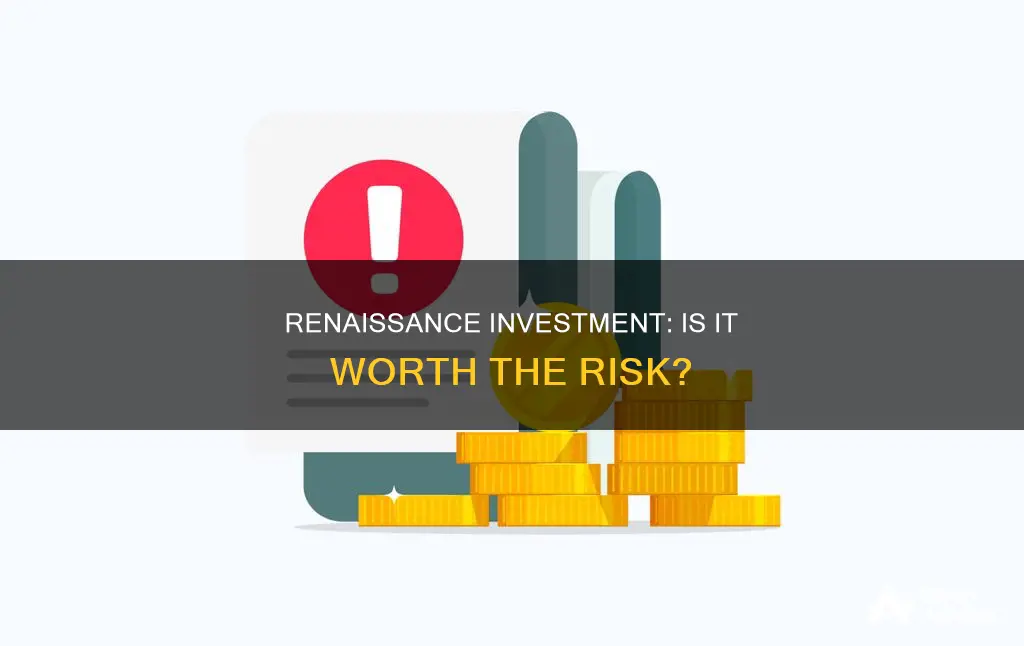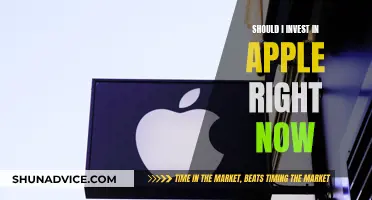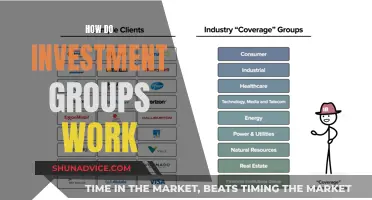
Renaissance Technologies, also known as RenTech or RenTec, is an American hedge fund that employs mathematical and statistical methods to inform its investment strategies. The company was founded in 1982 by James Simons, a mathematician and former codebreaker. Renaissance offers a range of funds, including the Medallion Fund, which is considered one of the most successful hedge funds in history, and the Renaissance Institutional Equities Fund (RIEF). While Renaissance has a strong track record of impressive returns, investing in the company is not straightforward as its funds are generally not available to the public. There have also been reports of a scam website, renaissance-investment.com, which claims to invest in various sectors but stopped paying investors in February 2018. However, Renaissance Capital, a separate entity, offers IPO ETFs that are accessible to investors through their broker's website or by contacting the company directly.
| Characteristics | Values |
|---|---|
| Company Name | Renaissance Technologies LLC |
| Also Known As | RenTech or RenTec |
| Type of Company | Investment management firm, hedge fund |
| Location | East Setauket, New York |
| Year Founded | 1982 |
| Founder | James Simons |
| Investment Approach | Quantitative analysis, mathematical and statistical methods |
| Notable Funds | Medallion Fund, Renaissance Institutional Equities Fund (RIEF), Renaissance Institutional Diversified Alpha (RIDA) |
| Website | www.rentec.com |
| [email protected] |
What You'll Learn

Renaissance Technologies' Medallion Fund
Renaissance Technologies is an American hedge fund and investment management firm based in East Setauket, New York, on Long Island. The firm was founded in 1982 by James Simons, a mathematician and former codebreaker.
Renaissance's signature fund is the Medallion Fund, established in 1988. The fund is famed for its impressive performance and has been described as the "best track record on Wall Street". Medallion is a private fund, and its investments are not listed on a public platform. However, it is known for its exceptional returns and has become synonymous with the idea of using mathematical models and algorithms for trading in financial markets.
The Medallion Fund has produced returns of 62% annualised returns before fees and 37% annualised returns net of fees from 1988 to 2021. In comparison, an investment of $1 in the Medallion Fund during this period would have grown to almost $42,000, while the same amount invested in the S&P 500 would have only grown to $40. The fund's performance is attributed to its use of quantitative models and advanced mathematics to analyse and execute trades, many of them automated.
The Medallion Fund is closed to outside investors and is now only available to current and past employees and their families. The fund's success has led to Renaissance Technologies offering two portfolios to outside investors: the Renaissance Institutional Equities Fund (RIEF) and the Renaissance Institutional Diversified Alpha (RIDA).
Investment Scams: Why the Fall?
You may want to see also

Renaissance Capital IPO ETFs
Renaissance Capital's IPO ETFs are a smart way to invest in initial public offerings (IPOs). The Renaissance IPO ETF (ticker: IPO) provides investors with access to a basket of the largest, most liquid US-listed newly public company stocks in one security. This reduces the risk of single-stock ownership and avoids overlap with major core indices, providing optimal diversification across markets and time.
The Renaissance IPO ETF is a transparent, rules-based fund that tracks the price and yield performance of the Renaissance IPO Index as closely as possible, before fees and expenses. The fund is rebalanced quarterly, including new IPOs and removing older constituents three years after their IPO. Each constituent is weighted by float-adjusted market capitalization, with a 10% cap on weightings.
The Renaissance IPO ETF offers investors exposure to innovative companies after their most important fundraising event in history. It provides an opportunity to invest in new stocks before they are added to core indices, allowing investors to get in early on large, newly-traded companies. The ETF has almost no overlap with the S&P 500, containing only new stocks with an average age of 2.2 years, providing a fresh alternative to the average portfolio, which tends to consist of older stocks.
The Renaissance IPO ETF has shown strong performance, climbing by over 40% in the last year and over 13% year-to-date in 2024. This is a testament to the fund's ability to capture the performance of the underlying Renaissance IPO Index and provide investors with access to some of the most promising newly public companies.
Renaissance Capital's IPO ETFs provide a unique opportunity for investors to diversify their portfolios, gain exposure to innovative new companies, and potentially generate strong returns by investing in US IPOs through a transparent and rules-based ETF structure.
Investing: Why the Fear?
You may want to see also

Renaissance Technologies' history and founder
Renaissance Technologies, also known as RenTech or RenTec, is an American hedge fund based in East Setauket, New York, on Long Island. It was founded in 1982 by James Simons, a mathematician and codebreaker during the Cold War. Simons graduated from the Massachusetts Institute of Technology with a bachelor's degree in mathematics and later obtained a PhD in mathematics from the University of California, Berkeley. He then worked at the Institute for Defense Analysis and taught mathematics at MIT and Harvard University.
Simons founded Renaissance Technologies following a decade as the Chair of the Department of Mathematics at Stony Brook University. The firm uses quantitative trading, employing specialists with non-financial backgrounds, such as computer scientists, mathematicians, physicists, signal processing experts, and statisticians. This approach sets Renaissance apart as a firm run by and for scientists.
The firm's signature fund, the Medallion Fund, was established in 1988 and has been key to the company's success. The Medallion Fund utilises mathematical models and algorithms to make investment gains from market inefficiencies, achieving impressive returns over the years.
Simons led Renaissance Technologies until his retirement in 2009 but remained involved as a non-executive chairman and investor until his death in 2024. The company is currently run by Peter Brown, a computer scientist who joined Renaissance in 1993.
Pay Off Car Loan or Invest: Where Should Your Money Go?
You may want to see also

Renaissance Technologies' investment approach
Renaissance Technologies, also known as RenTech or RenTec, is an American investment management firm that employs mathematical and statistical methods in the design and execution of its investment programs. The firm was founded in 1982 by James Simons, a mathematician and former codebreaker. Renaissance Technologies is known for its heavy reliance on quantitative analysis and algorithmic strategies to drive its investment decisions.
The firm's signature Medallion Fund, established in 1988, is considered one of the most successful hedge funds in history. The Medallion Fund is not open to outside investors and is primarily for company employees and select individuals. It has generated average annual returns of 66% before fees and 39% after fees over a 30-year period from 1988 to 2018. The fund's success is attributed to its use of advanced mathematical models and algorithms to identify and exploit market inefficiencies.
- Quantitative Analysis and Algorithmic Strategies: The firm employs a diverse team of scientists, including mathematicians, physicists, and computer scientists, to develop trading algorithms. These algorithms are designed to identify patterns and anomalies in market data, allowing them to make profitable trades. This approach involves analysing vast amounts of market data, including historical pricing data, to predict price movements and generate profitable trades.
- Machine Learning and High-Performance Computing: Renaissance Technologies utilises machine learning and high-performance computing capabilities to process and analyse large volumes of data. This enables them to identify non-random events and market signals that may impact investment decisions.
- Unconventional Approach to Stock Investment: Unlike traditional methods that rely heavily on fundamental analysis, Renaissance Technologies adopts a quantitative trading approach. They disregard economic fundamentals and focus on exploiting market inefficiencies across various asset classes such as equities, futures, and commodities.
- Talent and Culture: Renaissance Technologies prioritises attracting and retaining top talent, fostering a culture of academia. The firm encourages employees to approach problems with intellectual curiosity and rigour, fuelling innovation and allowing them to stay at the forefront of quantitative trading strategies. The firm's team comprises individuals from diverse academic backgrounds, including physicists, mathematicians, and computer scientists.
- Secretive Nature: Renaissance Technologies is known for its secretive nature and low personnel turnover. The firm requires its researchers to sign non-compete and non-disclosure agreements to protect the intellectual property and confidentiality of its trading strategies.
Overall, Renaissance Technologies' investment approach is characterised by its heavy reliance on quantitative analysis, advanced mathematical models, and a talented team of scientists. The firm's unique approach has revolutionised the investment industry and set a new standard for investing.
Best ETFs to Invest in Now
You may want to see also

Renaissance Technologies' risks and challenges
Renaissance Technologies, also known as RenTech or RenTec, is a hedge fund that stands out in the investment world for its heavy reliance on mathematical and statistical methods. The firm was founded by mathematician James Simons, who is known for his unique investment strategies. Here are some of the risks and challenges associated with Renaissance Technologies:
Risks and Challenges of Renaissance Technologies:
- Market Volatility: Renaissance's strategies rely on complex algorithms and rapid execution, which may not always perform as expected, especially during periods of high market volatility. In 2007 and 2020, for example, Renaissance's funds struggled due to higher market volatility.
- Potential Losses: The possibility exists that Renaissance's strategies may not always generate positive returns, and investors could face potential losses.
- Secrecy and Lack of Insight: Renaissance is notoriously secretive about its trading strategies and decision-making processes. This lack of transparency can make it challenging for investors to fully understand the risks involved and make informed decisions.
- High-Frequency Trading (HFT) Risks: Renaissance is known for its HFT strategies, which involve executing a large volume of trades at high speeds. This approach carries the risk of technological failures, market liquidity issues, and increased regulatory scrutiny.
- Tax and Regulatory Issues: In 2014, Renaissance was involved in a tax avoidance investigation related to its trading strategies. While the issue was eventually settled, it highlights the potential regulatory and tax risks associated with the firm's complex strategies.
- Model Risk: Renaissance's reliance on mathematical models and algorithms assumes that market behaviour can be predicted and exploited. However, there is a risk that these models may not always accurately capture market dynamics, leading to potential losses.
- Competition: While Renaissance has a strong track record, the investment landscape is highly competitive, and other firms may develop strategies that outperform Renaissance's approaches.
- Key Person Risk: Renaissance's success has been closely tied to its founder, James Simons. His retirement and subsequent passing in 2024 could impact the firm's future performance and direction.
- Limited Investment Opportunities: Renaissance's most successful fund, the Medallion Fund, is closed to outside investors and primarily serves company employees. This limits the investment opportunities for individuals interested in investing with Renaissance.
While Renaissance Technologies has a reputation for impressive returns, potential investors should carefully consider these risks and challenges before making any investment decisions.
Cruise Investments: Worth the Money?
You may want to see also
Frequently asked questions
Renaissance Technologies, also known as RenTech or RenTec, is an American hedge fund that employs mathematical and statistical methods in its investment programs.
Renaissance Technologies is a legitimate investment management firm. However, there is a scam website called "renaissance-investment.com" that claims to be a legitimate investment project. This website stopped paying its investors on February 8, 2018.
Renaissance Technologies' funds are generally not available to the public. Their most famous fund, the Medallion Fund, is closed to outside investors and primarily serves company employees and select individuals. To invest in Renaissance Technologies, you would need to seek out one of their funds that is open to outside capital. Renaissance Capital also offers IPO ETFs that you can invest in through your broker.







